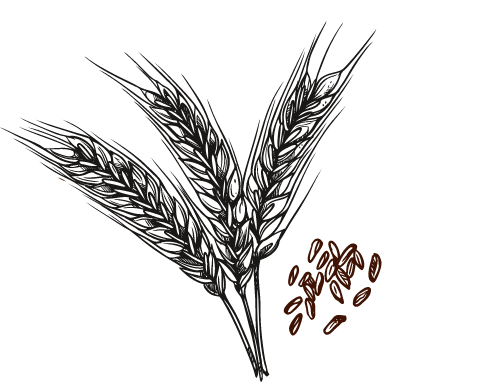What do sauerkraut and yogurt, pickles and sourdough have in common? Lactofermentation. This preservation process, well known to our grandmothers, is making a strong comeback with a long list of advantages: simplicity, naturalness, nutrition and delicacy.
What is lactofermentation ?
Fermentation is the most basic preservation method available ... and the most counter-intuitive, too, since it involves allowing microorganisms to proliferate on food. But not just anyhow! Lactofermentation is a specific mode of fermentation based on lactic bacteria, hence its name. We also talk about lactic fermentation.
How it works ?
Lacto-fermented foods are either naturally rich in lactic bacteria, such as vegetables, or mixed with lactic ferments, such as milk for yogurts. Liquid, immersed in a liquid or enclosed, food is isolated from the air. This isolation prevents the growth of bacteria, yeasts and pathogenic fungi which require oxygen to survive.
The microorganisms that develop under these conditions do not pose any risk to human health but produce enzymes that transform food: acids, vitamins, aromatic substances ... Result? They extend the food’s shelf life, enrich them with substances beneficial to the body and modify their flavors for the better. A matured cheese is a fermented cheese!

Milk and lacto-fermentation, the false friends
The link is quickly made, but incorrect: there is no milk in lactofermentation. The term comes from lactic bacteria producing lactic acid, and is not related to lactose. In contrast, lacto-fermentation is applied to milk to produce yogurt or cheese ... and one of the side effects of the process is the reduction or elimination of the amount of lactose in the products.
Lacto-fermentation’s benefits
If lacto-fermentation is making a strong comeback in food, it is because the method meets many current consumer demands. We take stock.
Shelf life
The result is unquestioned: raw milk can be kept for a few days, yogurts for a few weeks, certain cheeses matured for up to several years. And the same goes for all fermented foods, whose shelf life is multiplied, even tenfold.
Taste
Lactofermentation profoundly changes the foods concerned, whether it be in texture, smell or flavor. It is nothing more or less about ripening, this maturation process that transforms cheeses like Comté or Parmesan and improves food.
Naturalness
A natural preservation method if there is one, lacto-fermentation prolongs the life of food without chemical additives and without preservatives.
Nutritional benefits
Lacto-fermented foods contain living microorganisms, just like the bowel microbiota. For this reason, many benefits are attributed to the consumption of these foods:
- They feed the microbiota,
- Improve intestinal transit,
- Relieve certain ailments,
- Stimulate the immune system
- And would help prevent disease ...
At present and although much research is underway, the health claims are not scientifically proven. We know, on the other hand, that:
- Fermented products are richer in vitamins, nutrients or antioxidants than the same unfermented foods;
- They contain natural probiotics, protective bacteria, in large numbers and great diversity;
- They improve the absorption of many minerals found in food, such as calcium or magnesium;
- Lacto-fermentation improves the digestibility of food.
Balance sheet? No way to expect miracles, fermented products are not drugs. But there is no question of depriving yourself, as always without excess and by diversifying the types of fermented foods to vary the nutritional intake!
What are lacto-fermented foods?
Developed to extend the shelf life of milk, yogurts and cheeses are the most famous lacto-fermented products. Sauerkraut is nothing but lacto-fermented cabbage, the sourdough of bread, pickles and gherkins come from the same process ... as are kefir, kombucha, kimchi or nuoc-mam, olives or sausage dry!
How to make lactofermentation at home?
Lacto-fermentation is the easiest do-it-yourself fermentation method, without any special materials or ingredients. Thinking to take steps? Follow a few simple rules.
- Provide perfectly airtight glass jars with a rubber seal.
- Cut and seed the vegetables according to their type and your wishes: grated, sliced, sliced, large dice ...
- Place the vegetables at the bottom of the jars, packing well.
- Fill with salt water, at the rate of two tablespoons of salt to one quart of water, to two centimeters from the rim of the jar.
- Tamp again and seal tightly.
- Leave to stand for three days in a dark place at room temperature, then store in a slightly cooler place, if possible around 18°C.
- Leave to ferment on average three weeks before consuming. The shorter the fermentation, the crunchier the vegetables; the longer it is, the more tender and tangier they are.
Lactofermentation: tips from regulars
- Prefer organic vegetables for their nutritional quality and to avoid having to peel them: the majority of lactic acid bacteria are found in the skin.
- Use salt without iodine or anti-caking agent, such as sea salt.
- Flavor your preparations with seeds, herbs, berries, garlic ... and don't hesitate to mix different vegetables in the same jar.
- The most common method is vegetables in brine, in other words plain and then supplemented with salted water. They can also be salted directly, about 2% of their weight in salt, before filling the jar with unsalted water.
- Wash your hands and your utensils before preparation, but do not use an antiseptic solution which will kill the good bacteria necessary for lacto-fermentation.
- Lacto-fermentation rarely fails with vegetables. If it has not happened, however, it is hard not to notice, the smell is enough to tell ... in this case, do not eat the food!
- Once the jar has been opened and exposed to the air, store it in the refrigerator to prevent mold and consume it within two weeks.
- Don't hesitate to use your fermented foods in cooking recipes: a mixture of vegetables works wonders with warm green lentils with smoked trout or herring with sweet potatoes, and raw sauerkraut is perfect with apple and beetroot.
Which vegetable for lacto-fermentation ?
Almost all vegetables are suitable for lactofermentation! The best known are cabbages, but the method applies equally well to carrots, leeks, radishes, cucumbers, green beans, celery, turnips, peppers, squash, beans ... some fruits are also suitable, such as apples, plums or pears, tomatoes and olives.








